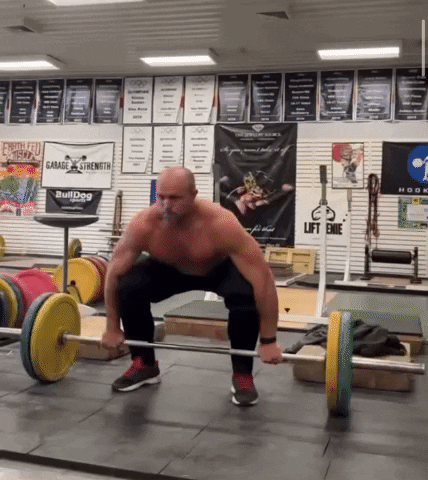How to Improve Bar Path in Olympic Lifting
FREE WEIGHTLIFTING WORKOUT!
Download by entering below

How To Get Faster Bar Speed For Olympic Weightlifting
In the world of weightlifting, the bar path is typically known as an abstract concept. Fortunately, specific tools and high-powered mobile-look-at-devices, like smartphones, allow us to break down the bar path and see what is going on.
Doing a snatch or a clean, a bar path that is vertical as possible is the ideal we want to work towards. It typically looks like the bar coming in a little bit to the shin, staying tight around the hips, and as it comes off the hip the bar path will look like a little bit of a J.
Understanding what muscles are being used (hamstrings, quads, feet, traps, glutes, hips, everything) will help us improve our vertical work to get as efficient as possible with the bar path.
Muscles Throughout The Pull
Looking at the bar path from the floor to the knees, we want to see the knees come back with the hamstrings and quads putting in work. Traveling through no man’s land, we will have more engagement come through the quads and the hips. Reaching the reciprocation point into the finish through the hips, we will be firing our glutes and quads; the quads especially on the finish. From the finish into the catch, we want to focus on the traps, rhomboids, and even the lats to a point.
So if we can think about the muscles, we can start to break down the bar path with a specific tool to identify where the bar path is traveling. If the bar is out of alignment, we can use a cue around a muscle group, a cue around a movement pattern, or, better yet, exercises around those patterns and muscles to stimulate better growth and proprioception which leads to a better bar path.
VMAX PRO
We use the VMAX PRO to see the displacement of the bar. We also get to see the peak velocity, rate of acceleration, and where any leaks are occurring through the bar’s path.

Looking at the VMAX PRO, we can see through metrics and graphs the acceleration of the bar and where dips in velocity occur. We can also see the bar path with a plus or minus readout. A plus means the bar moves slightly forward and minus means it moves toward the body. As the bar path travels into the power position, this is where we will see peak velocity readouts from the VMAX PRO. Essentially, the VMAX PRO tells us that keeping the bar as tight as possible, within 1 centimeter from the floor to the knee, will enable athletes to hit max acceleration right as the bar comes off the hip. For instance, my athlete Hayley Reichert achieves 1.97 meters per second at this point typically up to around 88% of her best snatch.

With the 3-D bar path readout, the VMAX PRO can show us the minimal movement from the floor to the knee and highlight the J into the finish. The 3-D read-out also helps establish a technical model for the desired bar path. The goal is to see the bar path maintained as the weight gets heavier and heavier on the bar. Along with the 3-D bar path, there is also a 2-D bar path readout. There are many metrics that the device gives as a read-out to help evaluate an athlete’s technical movement patterns.
The VMAX PRO also creates a lot of dynamic metrics for usage. For instance, comparing the speed of a clean pull to the speed of a clean out of the hole. We will also use the tool to compare the speed of the clean out of the hole to front squat speeds. We can establish correlations to get specific data to understand our athletes.

Establish A Technical Model
To move as tightly as possible and have the best technique, establish who the technical model will be. At Garage Strength, we use Kuo. Liu is another great athlete to use as a technical model.
Comparing vertical work in a ratio to horizontal work, the best technicians are over 90% vertical to horizontal work.
With the technical model set, exercises like the no feet snatch, a low hang snatch, and a muscle snatch where contact is made and plantar flexion is held into the finish can be used to improve the bar path.
An established technical model allows us to play around with the cues and understand the movement patterns needed to enhance our bar path and overall position.

A More Vertical Bar Path
Off the floor, we want to see “push the knees back” to have a minimal amount of the bar going forward. Around the knee, we want to see “push the knees under from a flat foot” so we want to pay attention to the heels being flat while the knees come forward and flex; this will help keep the chest over the bar and keep the bar tight. The simple cue of “keep the bar over the shoelaces” helps here too. Into the hip, we want to think “extend the hip with flat feet” so that we make contact with the bar while the feet are flat (that’s why we recommend no feet snatches). Off the hip, “big upper body” or “elbows behind the torso” and “slide those feet out” to stay grounded longer to apply force longer to enhance acceleration.
Recap
A bar path needs to be vertical. Achieving a vertical bar path is easier by using a tool like the VMAX PRO. We also want to establish and use a technical model like Liu or Kuo. We also want to use specific lifting variations to improve muscular movement patterns. Put in the work, focus on the mental acuity, and reap the rewards of a more vertical bar path.
Related Posts
Blog Topics

Yo, It's Dane
Welcome to the Garage Strength Blog, where it is my goal to provide you with the experience and knowledge I've gained in the strength and conditioning world over many years of learning from both successes and failures. I train elite-level athletes in a multitude of sports from the high school to professional levels, already producing 5 Olympics and 30+ National Champions. If you want to be the next champion I train, check out my strength programs below!
Start Training With Me

Join for free educational videos EVERY WEEK on strength coaching and athletic performance



